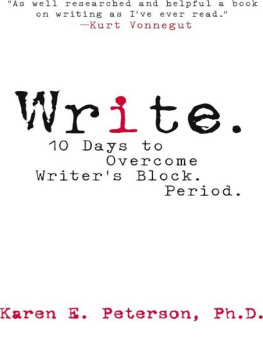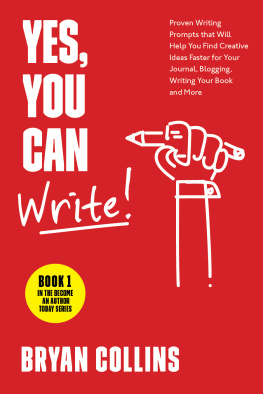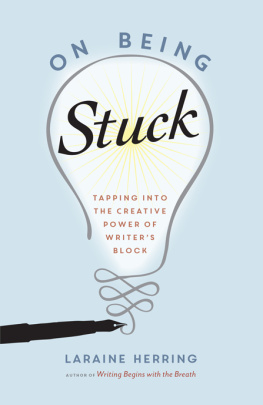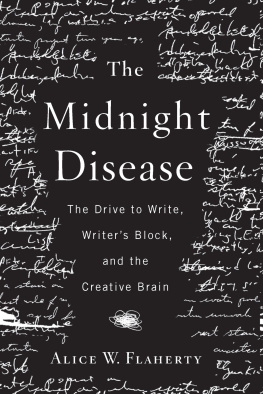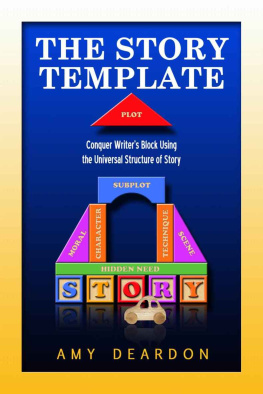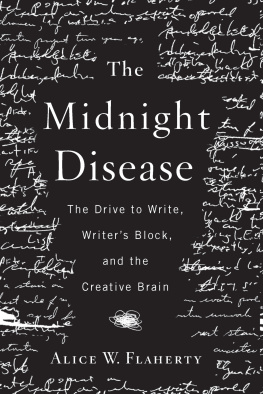Dedication
For Kurt Vonnegut,
Who keeps us laughing
all the way to the gallows
and back.
... and for Denise Levertov,
who so elegantly
granted me
permission
to write.
... and for Steven A. Carreras,
who has helped me
see clearly
now.
Is there something that will go unsaid if you dont write?
Denise Levertov, personal communication, 1987
The plot is just a bribe to keep them reading.
Kurt Vonnegut, Case Western Reserve University, 1985
contents
shaping your life as a writer
the bi-vocal way
permission to write:
how to find both your voices (and ditch theirs)
the all-or-nothing writer:
how to stop feeling overwhelmed
steal this time:
how to liveand writeon 168 hours a week
a clean, well-lighted place to write:
your place or theirs?
getting in the mood:
how to overcome the write-or-flight response
daring to write
the bi-vocal way
starting to write:
remembrances of things past
continuing to write:
the plot as bribe
finishing writing projects:
always busy, never done
publishing writing projects:
from panic to press release
10 days to get out of your own way
the bi-vocal way
what a difference a day makes:
how to choose the write response
day 1:
task-sprinting chart
day 2:
task-sprinting chart
day 3:
task-sprinting chart
day 4:
task-sprinting chart
day 5:
task-sprinting chart
day 6:
task-sprinting chart
day 7:
task-sprinting chart
day 8:
task-sprinting chart
day 9:
task-sprinting chart
day 10:
task-sprinting chart
appendices:
your to-go order of motivation
Acknowledgments
There are so many people who have helped in the creation of this book, I could probably write another book about how grateful I am for their support. I am especially appreciative of the work done by so many clinicians and researchers who have pioneered the area of writing as therapy (in particular, Dr. Lucia Capacchione and Dr. James Pennebaker), as well as those who have helped us to understand the different functions of the left and right sides of the brain (most notably, Dr. R. Joseph and Dr. Allan Schore).
Id also like to thank my agent, Linda Roghaar, for her wisdom, unswerving support, and marvelous sense of humor. Id like to thank my editor, Paula Munier, as well as Andrea Norville, Jason Flynn, and the rest of the staff at Adams Media for their tireless support, attention to detail, and belief in my work.
I would also like to thank Christine Belleris for her perennial support of my ideas. I thank Lisa Ellis for being my friend/ editor/kindred spiritand especially for her encouragement in the creation of this book and my first two novels. I thank Paula Morgan-Johnson, who helped this book come to fruition and who encouraged me to use my voice. And, just because, I want to thank Abby Nelson for her concentric circles of effervescent support, wit, and artistic inspiration.
A special and timeless thank-you goes out to Steven A. Carreras, who has helped me see clearly now.
I also thank Kurt Vonnegut for his written snippets of support and encouragement over the years and for his fiction, which has so strongly influenced my own sense of gallows humor and the absurd. And, finally, I thank Denise Levertov, for unwittingly giving me permission to write one warm spring afternoon.
Authors Note
And why do I know so much about writers block? Because Ive had itin both senses of this phrase.
Ive also had it across genres (fiction, nonfiction, poetry), and across careers (English teacher, psychologist, and workshop facilitator).
Now, its not that I never get blockedI just know what to do about it. Finally.
Over the past twenty years, with clients as well as program participants, Ive developed the bi-vocal approach to conquering writers block. Its really this simple: We need to fight writers block with both sides of the brain, but most of us use only one side. As Dr. R. Joseph says in his groundbreaking book, The RightBrain and the Unconscious: Discovering the Stranger Within :
Although the right brain appears to be the more creative aspect of the mind, for example, in the form of artistic expression, creativity is possibly a product of having two brains and two minds. Indeed, the creative process is perhaps made possible, at least in part, by the interpretation and guesswork that occur when the two different brains and regions of the mind tackle the same problem and then try to communicate with each other. (pp. 201202)
Along with the work of Dr. Joseph, I would like to express my appreciation for the work of so many other researchers and clinicians whounbeknownst to themcontributed to the origins of the bi-vocal approach, which has a strong foundation in research and clinical practice. For example, psychologists such as Dr. James Pennebaker ( Opening Up and Writing to Heal ) have conducted extensive research on the therapeutic effects of writing about stress, and the American Psychological Association has recently published a book comprised of research articles on the therapeutic power of writing ( The Writing Cure ). These research results have provided the basis for the bi-vocal approachs use of writing as a form of stress management and self-knowledge.
Additionally, over the last few decades, some clinicians began to use writing to access the right side of the brain (albeit without asking the same questions of the left side of the brain). For example, as a form of what Gestalt therapists call dialoguing, in an attempt to access the disowned parts of the self, some practitioners asked clients to write with their nondominant hand, and this approach was then popularized in self-help books by therapists such as Dr. Lucia Capacchione ( The Power of Your Other Hand ) and John Bradshaw ( Homecoming ). Additionally, Dr. Capacchione also encouraged readers to write back and forth with both hands; however, she has focused primarily on issues such as childhood trauma rather than writers block, and she has erroneously assumed that the nondominant hand will by definition express the voice of an encouraging, creative self. Nevertheless, I am thankful for her groundbreaking work in this area, which helped provide the impetus for my work with writers.
Other researchers and therapists have focused on alternately stimulating the right and left sides of the brain, although they have not specifically used writing as a modality. For example, Dr. Fredric Schiffer ( Of Two Minds ) has conducted research and provided treatment through what he calls dual brain psychology, in which he asks clients to cover one eye while thinking about a problem for a few minutes, then switch and cover the other eye while thinking about the same problemoften with strikingly different results, as displayed in simultaneous brain scans. Similarly, positive research results have also been reported by practitioners of EMDR (see EyeMovement Desensitization and Reprocessing by Francine Shapiro), who employ bilateral stimulation of the brain providing rapidly alternating sensory stimulation (through lights, sounds, or tactile pulsars) to the right and left brain hemispheresin order to help clients in psychotherapy change. These clinicians and researchers have provided the basis for the bi-vocal approachs use of activating the voices of both sides of the brain.
In building uponand with much appreciation ofthe earlier work of these researchers and practitioners, I have designed the bi-vocal approach as a specific technique for overcoming writers block. The two main components of the bi-vocal approach are the
Next page
